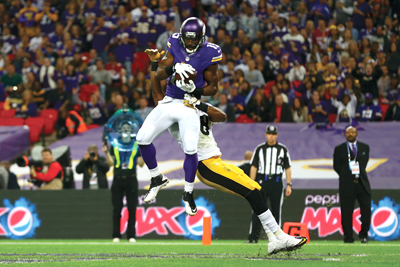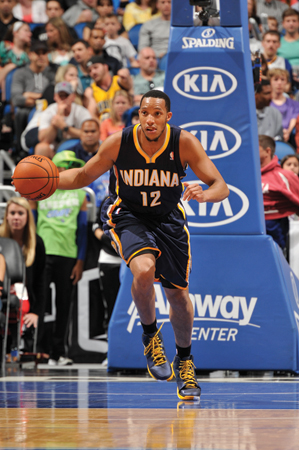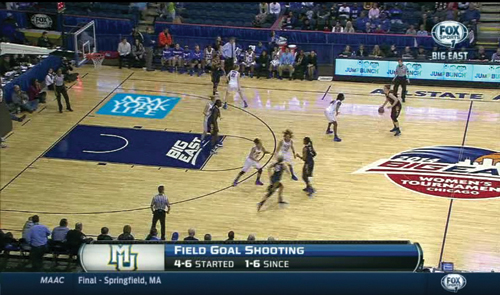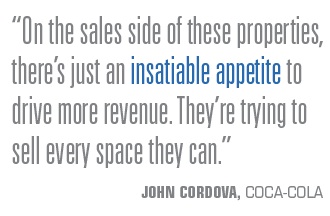At a recent team partner summit, NBA Commissioner Adam Silver said that uniform ads were “highly likely” in the league. Moments later, an agency head asked Silver to explain how that would work, given the possible conflicts. A uniform ad, for example, could clash with an athlete endorsement, or with a rival brand that bought national NBA TV ads.
“Could you explain the ground rules?” asked Michael Neuman, managing partner of Scout Sports and Entertainment, noting the potential inconsistencies and seeking clarity.
“You’ve just explained why we’re not doing it yet,” replied Silver, whose league has been debating the merits of having a 2.5-inch square ad patch for more than a year. “It has less to do with aesthetic concerns and more with practical business implications.”
 |
The NFL allows signage along the perimeter of the field for games played in London, where fans are used to such messaging at soccer matches. Such signage is still off limits back in the U.S.
Photo by: Getty Images |
That feeling is true across sports. As one of the last DVR-proof TV offerings, and one of the final places to reliably aggregate mass audiences, the value of any camera-visible signage has increased over the past decade, even as supply has escalated.
With an unyielding and ever-increasing sales imperative driving everyone selling venue signage or broadcast advertising, the race toward new inventory is inevitable.
Advertisers’ insatiable quest for camera-visible signage in sports will catalyze the inevitable arrival of new inventory like uniform signage, on-field branding and virtual advertising.
But talk of added inventory revives the debate over clutter, not to mention how to navigate the murky and often conflicting rights held by a league and its teams, players, venues and broadcasters.
Uniform policy
Advertising on uniforms has actually been permitted by every big U.S. league except the NBA for decades. It’s just been reserved for the apparel manufacturers, since that seems endemic.
The NBA has been the only holdout here. Some have suggested that a solution to the struggles between big- and small-revenue teams that have prevented the league from adopting uniform ads could be resolved with a deal that allowed rights holder Adidas to move its logo from NBA warm-ups to jerseys.
Across large sports properties, additional branding on or around the field of play seems likely before uniform ads.
“It’s an easier decision,” said SportsNet New York President Steve Raab, once vice president of marketing at Starter, a defunct licensed apparel company that had on-field NFL rights. “So if I’m the NFL, I’m selling ads on the
 |
Courtside signage is plentiful in the NBA, but for now player uniforms remain free of corporate branding.
Photo by: NBAE / Getty Images |
first down line a long time before I’m selling uniform space.”
Naturally, those teams with the most valuable intellectual property will resist.
“Ultimately, it would take a complete uniform redesign,” said Tom McGovern, president of Optimum Sports. “Are historic franchises going to be willing to do that?”
Sponsors typically fret over the fan reaction that the next on-field ad incursion will bring. In every case, except for the infamous case of a 2004 MLB deal that would have put “Spider-Man 2” movie logos on the bases at 15 ballparks for a weekend, the backlash has been negligent.
“When we brought in courtside signage more than 15 years ago, people said it was the end of the world,” Silver recalled. “It wasn’t.”
NBA teams are now looking to sell “apron” court signage, adjacent to the now accepted digital courtside signs.
As MLB’s “Spider-Man 2” experience illustrates, however, there are different standards for different properties.
Artfully bridging that gap will be the task of those who will be buying and selling the next generation of venue signage.
“NASCAR fans know that sponsorship pays for the sport,” said Adam Dettman, director of sports and entertainment marketing at MillerCoors. “That hasn’t been the case in stick-and-ball sports, but I think that’s just a matter of time. As long as the team’s putting the best product on the field, acceptance will follow.”
Sign of the times
What sports venues will look like in 10 years is about as difficult to predict as who will win a NASCAR race after the initial lap. Aside from the many-layered conflicts among teams, leagues and broadcast rights holders, many of the largest brands are questioning the need for branding when they already have high brand recognition.
“Traditional signage is not a must-have for us,” said John Cordova, Coca-Cola’s director of sports transaction management, now more concerned about the proliferation of digital signage. “Most of our conversations about signage now is how we’re going to change the message from something passive to something interactive.”
 |
New York Life took advantage of virtual advertising during Fox basketball coverage.
Photo by: Fox |
Added Dettman, “Signage is certainly not our No. 1 priority when we discuss a [team/venue] partnership. It’s additive.”
However, at sports properties, the pressure for incremental sponsorship revenue is far greater than the pressure to put a winner on the field.
“Teams are very accustomed to selling you signage, whether or not you want it,” said Greg Via, director of global sports marketing at Gillette. “I’d rather have a spot or put that money to work at retail.”
Brands are also seeing the need for new spending on digital, social and experiential marketing efforts.
“So many ad dollars are being dedicated to different media now [that] there’s less of an appetite for hard signage,” said Jeremy Carey, managing director at Optimum Sports, which has a client roster including sports marketers like FedEx, Pepsi, Under Armour and State Farm. “For a lot of the big spenders, it’s not about awareness or branding, it’s about incorporating an action message, and that message is constantly evolving.”
Whether that means a stadium opening in 20 years could end up with entirely digital signage, or even a blank canvas where all advertising is inserted at the whim of the broadcaster, depends on who’s looking into their crystal ball.
“We’ll never see a totally blank stadium,” said Phil Pacsi, Bridgestone vice president of consumer marketing, who oversees sponsorships across the NFL, NHL, MLB and more than 25 teams. “You want to be able to point your sign out at the game. If it’s electronic, we’ll even take advantage of that to put our business partners up there.”
For years venue signage pioneer Jerry Cifarelli’s ANC Sports has been hearing about the threat virtual signage shown by broadcasters poses to his behind-the-plate MLB signage. While Fox’s MLB broadcasts feature virtual signage, the vast majority of the time ANC’s 14 MLB teams are rolling paper signs behind the plate.
“There will always be a battle between the broadcaster’s rights and team’s rights and there’s still an aspect of being there physically at the park that’s valuable,” Cifarelli said. “It’s the reason people still go to games when everything’s on TV. There’s still magic to being there.”
What about clutter?
For advertisers, there will always be some amount of prestige associated with having venue signage and the suites, which are usually packaged with sponsorships. Still, even that cachet could fall victim to better ROI models and the increasing influence of corporate procurement offices.
“The definition of clutter often gets down to what a team needs to sell,” said Tony Schiller, a principal at sports sponsorship and marketing agency Paragon Marketing, and someone who was once on the other side of the table in signage negotiations for the American Hockey League’s Chicago Wolves and Cleveland Cavaliers. “Brands are getting much more sophisticated about setting objectives and measuring performance, and signage is still very much an abstract rather than a tangible ROI.”
If established brands are shying away, “those looking to get on the map will always need branding. So there will always be physical signage of a sort,” said Dennis Mannion, president and CEO of Palace Sports & Entertainment.
The Palace at Auburn Hills is adding a new arena scoreboard and concourse signs that will employ beacons to relay specific offers to fans walking by with their Pistons mobile app open.
“Clutter itself is an intuitive line,” added Mannion. “Within the entrances and concourses, you don’t want it to be the intersection of Times Square and Tokyo — then people will just run to their seats.”
Repucom’s business is based on evaluating the TV value of venue signage. Founder and CEO Paul Smith said that at least 25 percent of his firm’s clients are consistently asking for “white space analysis,” which translates to “what’s the value if I put a sign here.”
Still, Smith said that while there are more brands in sports than ever, they are not taking up more real estate. There
are just more brands popping in and out as things like digital signage increase.
“Clutter is misunderstood,” Smith said. “Clutter is when there are lots of brands on screen at one time. What we know from our analysis is that most TV exposures show two or three brands. The clutter issue is often created by people’s distinction when they walk into a building. In terms of what fills the TV screen, it’s still pretty tight.”
Boston Red Sox Chief Operating Officer Sam Kennedy said that clutter “is in the eyes of the beholder,” noting that Fenway Park’s famed Green Monster now carries signs for Foxwoods Resort Casino, Infiniti and Sapient. Covidien was the first and only advertiser there in 2007.
“We’ve added a lot of inventory,” acknowledged Kennedy, who has seen sponsorship revenue increase around 10 percent after last year’s championship. “As long as you demonstrate that you are using those revenues to fund the baseball operation, fans will understand.”
Bridgestone’s Pacsi said clutter is directly dependent on the company’s relationship with teams, buildings or leagues. “At the Bridgestone Arena here in Nashville, I don’t think there could ever be too many Bridgestone signs,” Pacsi said.
The signage providers are hopeful of a time when less is more, but the future of virtual signage is less than assured.
“I could see a league take a virtual signage position across all its clubs by offering each team a decent guarantee,” Van Wagner Sports President and CEO Jeff Knapple said. “The overlapping rights issues are confusing and so the [virtual] business hasn’t grown as much as some might have thought. Still, I’ve been involved in quite a few naming-rights deals where we dealt with this [virtual signage] contractually on a contingency basis.”
Knapple sees the kind of perimeter signage common on English Premier League fields coming to the NBA someday, “but not until they would yield more revenue than the seats they would block,” he said.
ANC’s Cifarelli looks toward a time when, with better integration, his technology will enable automated display of a single brand across an entire arena after a particular event, say a three-pointer in basketball or a goal in hockey.
Still space available
Repucom’s Smith said an economic imperative in sports, of the sort that pushed oil prices high to where things like fracking and shale oil were economically viable, will eventually produce things like broader use, uniform ads or even on-field branding in the NFL, where some of the league’s largest deals are those that include sideline branding for the likes of Gatorade, Microsoft and Bose. If broadcast rights deals continue to escalate exponentially, additional camera-visible signage will probably be what supports it.
Many of the marketers interviewed for this story see the ability of CBS’s new Thursday night NFL package to attract sufficient advertising as a critical test.
“There’s only a certain number of advertisers that can build presence in the NFL, based on the cost of entry,” said Optimum Sports’ Carey. “Now they are adding more supply.”
Since the NBA is one of the few big sports properties with a media rights deal in the balance, that deal will help define what’s clutter and what’s inventory. Many media executives note that sports telecasts themselves are among the cluttered environments, as rights holders tout the rest of their programming schedule, often during game action.
Whatever the outcome of the clutter debate, standards will change, and commercial activity on the field of play will be determined less by fan perception, and more by that sometimes caustic mix of overlapping team, league, venue and broadcast rights, amplified by an eternally increasing sales imperative for teams and venues.
“I’ve never seen sales goals at teams go down and as long as people keep raising those, you are going to have a very hard time not having clutter because they have to find new opportunities,” said Marc Bluestein, founder of sports consultancy Aquarius Sports & Entertainment.
“On the sales side of these properties, there’s just an insatiable appetite to drive more revenue,” said Coke’s Cordova, who saw every side of the signage sales game while with Miller Brewing and the Milwaukee Brewers, before joining Coke in 1994. “They’re trying to sell every space they can.”
The value of NBA on-surface branding
Repucom studied the value of branding on NBA playing courts, which is now utilized by arena naming-rights partners. Among the highlights:
■ During the 2013-14 NBA regular season, naming-rights partners received nearly $57,000 in media value on average during locally televised games. Games on TNT and ESPN averaged more than $200,000 in media value per game, while broadcast national games on ABC averaged more than $1.1 million in media value for the naming-rights partner.
■ Repucom found that exposure values increase dramatically for the naming-rights partners during the playoffs and finals. Based on the 2013 NBA playoffs, on-surface branding generated more than $600,000 in media value per game across TNT and ESPN broadcasts, while ABC broadcasts averaged more than $2 million per game.
During the 2013 NBA Finals between the Miami Heat and San Antonio Spurs, naming-rights partners AT&T and American Airlines averaged $8.3 million in media value across the series.
Repucom calculates media value in sports broadcasts based on factors such as logo size, duration on screen, location and the number of times it appears.
Brand awareness in German soccer
Some of the most fertile ground for branding around the playing surface is European soccer. Repucom compared brand awareness of sponsors on different locations with brands appearing in television ad breaks, collecting data from 2007-10 after top games of Bundesliga, the German Cup or the German national team.
Among the findings:
■ Fans were 2.9 times more likely to recall sponsors appearing on player jerseys vs. standard commercial advertisements.
■ Fans were 2.3 times more likely to recall sponsors appearing on digital video boards vs. standard commercial ads.
■ Fans were 1.9 times more likely to recall sponsors appearing on the “pitch mat” (signage placed on the edge of the playing service) vs. standard commercial ads.
■ Fans were 1.7 times more likely to recall sponsors appearing on static video boards vs. standard commercial ads.
■ Fans were 1.3 times more likely to recall sponsors appearing on media backdrops (used for such things as in the booth or for interviews) vs. standard commercial ads.
Source: Repucom







